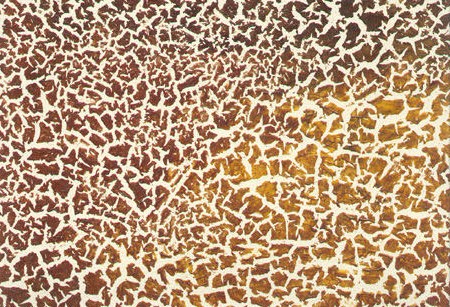This ‘old paint’ effect is great for uneven surfaces – the glaze will create a lumpy, bumpy finish and give the impression of many layers of paint hiding underneath.
This technique is simple to do and is a fun way to use very strong colors together. Try experimenting with unusual color combinations – even bright colors that you would not normally consider using together can create interesting effects in this way. I used emulsion paint to decorate these floorboards and there is a huge range of colors to choose from.
I used a deep violet color as a basecoat, with a fairly strong pink on top of this. I then softened the pink with a much paler pink wash.

You can make the effect as subtle or as strong as you like simply by altering the amount of beeswax you apply to the boards. You could also add more colors to the effect; just continue to layer colors on top of the base color, adding beeswax at each stage before you add the crackle glaze. It is helpful to do a practice run before the weekend on a spare piece of board – you might be amazed at the colors you eventually decide to use!
Apply a basecoat of emulsion paint to the boards the night before you start this project. Before buying the paint, check the coverage on the tin. The exact amount you will need will depend on your room size.
Day One
- Having applied a basecoat of matt emulsion paint the night before, apply beeswax cream on a thin brush. Concentrate on the edges of each board that would naturally show wear first, but put some small blobs here and there on the boards. Apply the wax in lumps and unevenly; this will dry overnight.
- Apply a coat of crackle glaze over the whole floor. Paint it on unevenly, but using long brush strokes in the direction of the floorboards This is important, as the cracks will appear where you apply this glaze, and the form that they take will be determined by how you apply it. Allow the glaze to dry; it should lake about two hours, depending on the temperature.
- When the crackle glaze is dry, apply pink emulsion paint on top of it, and let this coat dry.
Day Two
- Cracks and blisters will have appeared in the paint. Rub some diluted top color (here, a very light pink) over the surface.
- With a wide filling knife or a paint scraper, chip off the beeswax along the edges of the floorboards.
- Use a wide filling knife or a paint scraper to scrape across the boards, chipping off the beeswax haphazardly.
- Use a kitchen scourer to rub off more paint here and there.
- If you have chipped off too much paint, paint in the base color with a thin brush. You may, of course, prefer this effect, with yet another color showing through, and decide to leave it. Finally, when dry, apply acrylic floor coating to protect the surface.
Checking the suitability of boards for distressing: This technique can be used with matt emulsion paint only. Make sure that the basecoat is suitably prepared so that the paint adheres well. This effect is not suitable for floors that have already been painted with a hard eggshell paint or a varnish.